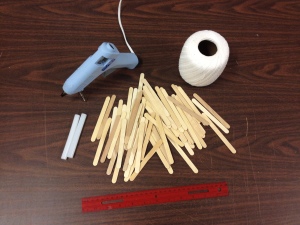February 9, 2015
 by: Evan Jones
by: Evan Jones
How the SpillNot works:
When you hold a cup of juice while walking, the juice tends to spill because the cup accelerates forward (ax, FIG.1, green arrow) and backward (-ax) with each step. The juice tips in response to that acceleration, and may spill over the rim of the cup.
 The Spill Not automatically tips the cup so that its top stays parallel to the juice surface (FIG.2). For example, if the juice surface tips to 30 deg, but the cup stays horizontal, the juice could spill. But if the cup also tips to 30 deg, we get no spill! Note that there are only 2 forces on each portion m of juice…the weight mg down, and the buoyancy force Fb of the juice pushing at a right angle to the surface. These two forces result in a horizontal accelerating force ma (in red). We see from FIG.1 that
The Spill Not automatically tips the cup so that its top stays parallel to the juice surface (FIG.2). For example, if the juice surface tips to 30 deg, but the cup stays horizontal, the juice could spill. But if the cup also tips to 30 deg, we get no spill! Note that there are only 2 forces on each portion m of juice…the weight mg down, and the buoyancy force Fb of the juice pushing at a right angle to the surface. These two forces result in a horizontal accelerating force ma (in red). We see from FIG.1 that
Read the rest of this entry »
 2 Comments |
2 Comments |  College level, experiments, High School level, Physics | Tagged: acceleration, centripetal force, hands-on activity, homeschool, parent friendly, PBL, pendulum, phenomenon based learning, phenomenon-based science, Physics, science, Spill not |
College level, experiments, High School level, Physics | Tagged: acceleration, centripetal force, hands-on activity, homeschool, parent friendly, PBL, pendulum, phenomenon based learning, phenomenon-based science, Physics, science, Spill not |  Permalink
Permalink
 Posted by Tami O'Connor
Posted by Tami O'Connor
January 29, 2015
 by: Tami O’Connor
by: Tami O’Connor
As an elementary and middle school teacher and Girl Scout leader, I had a bag of tricks that I dug into frequently… One of my favorites was the gyrocopter. I always kept a template in my files and when teaching about air, friction, forces symmetry or flight, out it came. It was simple enough for kindergarten students to build, yet complex enough to hold the attention of eighth graders as we discussed principles of drag, the characteristics of flight or even just isolating variables in an experiment.
Nearly 400 years before the invention of the helicopter, Leonardo da Vinci sketched out a machine designed to compress air in order to obtain flight. When Igor Sikorsky designed the first successful helicopter in the late 1930’s, da Vinci’s spinning wing was his inspiration.
Today, you can easily build gyrocopters with your students to explore different designs and variables.
How Does a Gyrocopter Work?
Read the rest of this entry »
 2 Comments |
2 Comments |  Elementary level, experiments, Middle School level, Physics | Tagged: flight, helicopters, homeschool, parent friendly, PBL, phenomenon based learning, phenomenon-based science, science, science lesson, variables |
Elementary level, experiments, Middle School level, Physics | Tagged: flight, helicopters, homeschool, parent friendly, PBL, phenomenon based learning, phenomenon-based science, science, science lesson, variables |  Permalink
Permalink
 Posted by Tami O'Connor
Posted by Tami O'Connor
January 13, 2015
 by: Tami O’Connor
by: Tami O’Connor
Energy is transported by waves. That’s an important concept to teach students, but it’s not always an easy one for them to understand. At the beginning of our unit on the electromagnetic spectrum, my class and I made wave models so they could all see and understand how waves work.
The kids loved this activity when we did it in class and, when I run into former students, some tell me they still have their wave models hanging from their ceilings more than 10 years after we made them!
Materials:
- Popsicle Sticks
- Kite String
- Low Melt Glue Gun
- Ruler or Yard Stick
- Tape
- Pen, Pencil, or Marker
Read the rest of this entry »
 1 Comment |
1 Comment |  Elementary level, energy, experiments, High School level, Middle School level, Physics | Tagged: compression waves, DIY, electromagnetic spectrum, energy, homeschool, parent friendly, PBL, phenomenon based learning, phenomenon-based science, science, transverse waves, waves |
Elementary level, energy, experiments, High School level, Middle School level, Physics | Tagged: compression waves, DIY, electromagnetic spectrum, energy, homeschool, parent friendly, PBL, phenomenon based learning, phenomenon-based science, science, transverse waves, waves |  Permalink
Permalink
 Posted by Tami O'Connor
Posted by Tami O'Connor
October 9, 2014
 by: Donna Giachetti
by: Donna Giachetti
“In the spring
a young man’s fancy
lightly turns to thoughts of love.”
—Alfred, Lord Tennyson
Alfred may have a point, but these days our thoughts turn to darker, spookier things—zombies, ghouls, witches, monsters and ghosts (more about them later, scroll down to the end of the blog).

Why is autumn one of our favorite times of year?
Let us count the ways:
- A new school year…
- Cooler temperatures…
- Warm, cozy sweaters and boots…
- A procession of colorful fall foliage…
But best of all, there’s the anticipation of HALLOWEEN! What a wonderful time to be a mad scientist! Read the rest of this entry »
 Leave a Comment » |
Leave a Comment » |  Elementary level, experiments, Middle School level, static electricity | Tagged: brain, discrepant event, edible insects, Educational Innovations, experiments, fun experiments, halloween, hands-on activity, homeschool, parent friendly, PBL, phenomenon based learning, phenomenon-based science, science, Slime, static electricity |
Elementary level, experiments, Middle School level, static electricity | Tagged: brain, discrepant event, edible insects, Educational Innovations, experiments, fun experiments, halloween, hands-on activity, homeschool, parent friendly, PBL, phenomenon based learning, phenomenon-based science, science, Slime, static electricity |  Permalink
Permalink
 Posted by Tami O'Connor
Posted by Tami O'Connor
October 6, 2014
 by: Tami O’Connor
by: Tami O’Connor
After the birth of my youngest child I decided to get a teaching position at a school closer to home. Until that point, I had only taught in the elementary grades. As it turned out, a seventh grade science position had opened up in the middle school in the next town, and, shortly after I filed my application, I was called in for an interview. Because it was already early June when the opening occurred, things moved along rather quickly.
Read the rest of this entry »
 2 Comments |
2 Comments |  Elementary level, experiments, High School level, Middle School level, Physics | Tagged: air pressure, discrepant event, hands-on activity, microscale vacuum apparatus, PBL, phenomenon based learning, phenomenon-based science, science, vacuum jar |
Elementary level, experiments, High School level, Middle School level, Physics | Tagged: air pressure, discrepant event, hands-on activity, microscale vacuum apparatus, PBL, phenomenon based learning, phenomenon-based science, science, vacuum jar |  Permalink
Permalink
 Posted by Tami O'Connor
Posted by Tami O'Connor
 by: Evan Jones
by: Evan Jones The Spill Not automatically tips the cup so that its top stays parallel to the juice surface (FIG.2). For example, if the juice surface tips to 30 deg, but the cup stays horizontal, the juice could spill. But if the cup also tips to 30 deg, we get no spill! Note that there are only 2 forces on each portion m of juice…the weight mg down, and the buoyancy force Fb of the juice pushing at a right angle to the surface. These two forces result in a horizontal accelerating force ma (in red). We see from FIG.1 that
The Spill Not automatically tips the cup so that its top stays parallel to the juice surface (FIG.2). For example, if the juice surface tips to 30 deg, but the cup stays horizontal, the juice could spill. But if the cup also tips to 30 deg, we get no spill! Note that there are only 2 forces on each portion m of juice…the weight mg down, and the buoyancy force Fb of the juice pushing at a right angle to the surface. These two forces result in a horizontal accelerating force ma (in red). We see from FIG.1 that


 Posted by Tami O'Connor
Posted by Tami O'Connor  by: Tami O’Connor
by: Tami O’Connor
 by: Donna Giachetti
by: Donna Giachetti